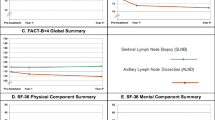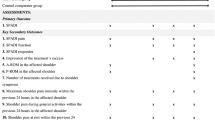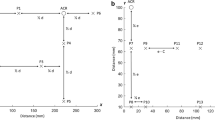Abstract
In order to determine the extent and time course of upper limb impairment and dysfunction in women being treated for breast cancer (BC), and followed prospectively, a novel physical therapy surveillance model post-treatment was used. Subjects included adult women with newly diagnosed, untreated, unilateral, Stage I to III BC, and normal physiological and biomechanical shoulder function. Subjects were excluded if they had a previous history of BC, or prior injury or surgery of the affected upper limb. Measurements included body weight, shoulder ranges of motion (ROM), manual muscle tests, pain levels, upper limb volume, and an upper limb disability questionnaire (ULDQ). Measurements were taken at baseline (pre-surgery), and 1, 3–6, and 12 months post-surgery. All subjects received pre-operative education and exercise instruction and specific physical therapy (PT) protocol after surgery including ROM and strengthening exercises. All measures of function were significantly reduced 1 month post-surgery, but most recovered to baseline levels by 1-year post-surgery. Some subjects developed signs of lymphedema 3–12 months post-surgery, but this did not compromise function. Shoulder abduction, flexion, and external rotation, but not internal rotation ROM, were associated with the ULDQ. Most women in this cohort undergoing surgery for BC who receive PT intervention may expect a return to baseline ROM and strength by 3 months. Those who do not reach baseline, often continue to improve and reach their pre-operative levels by 1-year post-surgery. Lymphedema develops independently of shoulder function 3–12 months post-surgery, necessitating continued monitoring. A prospective physical therapy model of surveillance allows for detection of early and later onset of impairment following surgery for BC in this specific cohort of patients.




Similar content being viewed by others
References
Kuroi K, Shimozuma K, Taguchi T et al (2006) Evidence-based risk factors for seroma formation in breast surgery. Jpn J Clin Oncol 36:197–206
Sugden EM, Rezvani M, Harrison JM et al (1998) Shoulder movement after the treatment of early stage breast cancer. Clin Oncol (R Coll Radiol) 10:173–181
Tasmuth T, von Smitten K, Hietanen P et al (1995) Pain and other symptoms after different treatment modalities of breast cancer. Ann Oncol 6:453–459
Yap KP, McCready DR, Narod S et al (2003) Factors influencing arm and axillary symptoms after treatment for node negative breast carcinoma. Cancer 97:1369–1375
Tengrup I, Nittby LT, Christiansson I et al (1999) Problems with arms are common after breast surgery. Lymphedema is a frequent complication in elderly women treated for breast cancer. Lakartidningen 96:5089–5091
Tengrup I, Tennvall-Nittby L, Christiansson I et al (2000) Arm morbidity after breast-conserving therapy for breast cancer. Acta Oncol 39:393–397
Herd-Smith A, Russo A, Muraca MG et al (2001) Prognostic factors for lymphedema after primary treatment of breast carcinoma. Cancer 92:1783–1787
Vinokur AD, Threatt BA, Vinokur-Kaplan D et al (1990) The process of recovery from breast cancer for younger and older patients. Changes during the first year. Cancer 65:1242–1254
Shamley DR, Srinanaganathan R, Weatherall R et al (2007) Changes in shoulder muscle size and activity following treatment for breast cancer. Breast Cancer Res Treat 106:19–27
Ridner SH (2005) Quality of life and a symptom cluster associated with breast cancer treatment-related lymphedema. Support Care Cancer 13:904–911
Isaksson G, Feuk B (2000) Morbidity from axillary treatment in breast cancer: a follow-up study in a district hospital. Acta Oncol 39:335–336
Ivens D, Hoe AL, Podd TJ et al (1992) Assessment of morbidity from complete axillary dissection. Br J Cancer 66:136–138
Bentzen SM, Dische S (2000) Morbidity related to axillary irradiation in the treatment of breast cancer. Acta Oncol 39:337–347
Ryttov N, Holm NV, Qvist N et al (1988) Influence of adjuvant irradiation on the development of late arm lymphedema and impaired shoulder mobility after mastectomy for carcinoma of the breast. Acta Oncol 27:667–670
Gosselink R, Rouffaer L, Vanhelden P et al (2003) Recovery of upper extremity function after axillary dissection. J Surg Oncol 83:204–211
Lee TS, Kilbreath SL, Refshauge KM et al (2007) Pectoral stretching program for women undergoing radiotherapy for breast cancer. Breast Cancer Res Treat 102:313–321
Wingate L (1985) Efficacy of physical therapy for patients who have undergone mastectomies. A prospective study. Phys Ther 65:896–900
Demark-Wahnefried W, Pinto BM, Gritz ER (2006) Promoting health and physical function among cancer survivors: potential for prevention and questions that remain. J Clin Oncol 24:5125–5131
Lauridsen MC, Christiansen P, Hessov I (2005) The effect of physiotherapy on shoulder function in patients surgically treated for breast cancer: a randomized study. Acta Oncol 44:449–457
Box RC, Reul-Hirche HM, Bullock-Saxton JE et al (2002) Physiotherapy after breast cancer surgery: results of a randomised controlled study to minimise lymphoedema. Breast Cancer Res Treat 75:51–64
Box RC, Reul-Hirche HM, Bullock-Saxton JE et al (2002) Shoulder movement after breast cancer surgery: results of a randomised controlled study of postoperative physiotherapy. Breast Cancer Res Treat 75:35–50
Michener LA, McClure PW, Sennett BJ (2002) American Shoulder and Elbow Surgeons Standardized Shoulder Assessment Form, patient self-report section: reliability, validity, and responsiveness. J Shoulder Elbow Surg 11:587–594
Heald SL, Riddle DL, Lamb RL (1997) The shoulder pain and disability index: the construct validity and responsiveness of a region-specific disability measure. Phys Ther 77:1079–1089
Roach KE, Budiman-Mak E, Songsiridej N et al (1991) Development of a shoulder pain and disability index. Arthritis Care Res 4:143–149
Kocher MS, Horan MP, Briggs KK et al (2005) Reliability, validity, and responsiveness of the American Shoulder and Elbow Surgeons subjective shoulder scale in patients with shoulder instability, rotator cuff disease, and glenohumeral arthritis. J Bone Joint Surg Am 87:2006–2011
Jester A, Harth A, Wind G et al (2005) Disabilities of the arm, shoulder and hand (DASH) questionnaire: determining functional activity profiles in patients with upper extremity disorders. J Hand Surg [Br] 30:23–28
Gummesson C, Atroshi I, Ekdahl C (2003) The disabilities of the arm, shoulder and hand (DASH) outcome questionnaire: longitudinal construct validity and measuring self-rated health change after surgery. BMC Musculoskelet Disord 4:11
Gummesson C, Ward MM, Atroshi I (2006) The shortened disabilities of the arm, shoulder and hand questionnaire (QuickDASH): validity and reliability based on responses within the full-length DASH. BMC Musculoskelet Disord 7:44
Macdermid JC, Solomon P, Prkachin K (2006) The Shoulder Pain and Disability Index demonstrates factor, construct and longitudinal validity. BMC Musculoskelet Disord 7:12
Dowrick AS, Gabbe BJ, Williamson OD et al (2005) Outcome instruments for the assessment of the upper extremity following trauma: a review. Injury 36:468–476
Paul A, Lewis M, Shadforth MF et al (2004) A comparison of four shoulder-specific questionnaires in primary care. Ann Rheum Dis 63:1293–1299
Bot SD, Terwee CB, van der Windt DA et al (2004) Clinimetric evaluation of shoulder disability questionnaires: a systematic review of the literature. Ann Rheum Dis 63:335–341
Lash TL, Silliman RA (2002) Long-term follow-up of upper-body function among breast cancer survivors. Breast J 8:28–33
Gerber L, Lampert M, Wood C et al (1992) Comparison of pain, motion, and edema after modified radical mastectomy vs. local excision with axillary dissection and radiation. Breast Cancer Res Treat 21:139–145
Kendall F, McCreary E, Provance P (1993) Muscles testing and function, 4th edn. Williams and Wilkins, Baltimore
Stout Gergich NL, Pfalzer LA, McGarvey C et al (2008) Pre-operative assessment enables early diagnosis and successful treatment of lymphedema. Cancer 112:2809–2819
Stanton AW, Northfield JW, Holroyd B et al (1997) Validation of an optoelectronic limb volumeter (Perometer). Lymphology 30:77–97
Hayes S, Cornish B, Newman B (2005) Comparison of methods to diagnose lymphoedema among breast cancer survivors: 6-month follow-up. Breast Cancer Res Treat 89:221–226
Armer JM (2005) The problem of post-breast cancer lymphedema: impact and measurement issues. Cancer Invest 23:76–83
Lin JJ, Hanten WP, Olson SL et al (2005) Functional activity characteristics of individuals with shoulder dysfunctions. J Electromyogr Kinesiol 15:576–586
Siegel KL, Hicks JE, Koziol DE et al (2004) Walking ability and its relationship to lower-extremity muscle strength in children with idiopathic inflammatory myopathies. Arch Phys Med Rehabil 85:767–771
Rudhe C, van Hedel HJ (2009) Upper extremity function in persons with tetraplegia: relationships between strength, capacity, and the spinal cord independence measure. Neurorehabil Neural Repair 23:413–421
Harris-Love MO, Shrader JA, Koziol D et al (2009) Distribution and severity of weakness among patients with polymyositis, dermatomyositis and juvenile dermatomyositis. Rheumatology 48:134–139
Motion Joint (1985) Method of measuring and recording. American Academy of Orthopedic Surgery, Chicago
Okunieff P, Augustine E, Hicks J et al (2004) Pentoxifylline in the treatment of radiation-induced fibrosis. J Clin Oncol 22:2207–2213
Gerber LH, Hoffman K, Chaudhry U et al (2006) Functional outcomes and life satisfaction in long-term survivors of pediatric sarcomas. Arch Phys Med Rehabil 87:1611–1617
Gutman H, Kersz T, Barzilai T et al (1990) Achievements of physical therapy in patients after modified radical mastectomy compared with quadrantectomy, axillary dissection and radiation for carcinoma of the breast. Arch Surg 125:389–391
Hladiuk M, Huchcroft S, Temple W et al (1992) Arm function after axillary dissection for breast cancer: a pilot study to provide parameter estimates. J Surg Oncol 50:47–52
Schmitz KH, Ahmed R, Troxel A et al (2009) Weight lifting in women with breast-cancer-related lymphedema. N Engl J Med 361:664–673
Swenson KK, Nissen MJ, Leach JW et al (2009) Case–control study to evaluate predictors of lymphedema after breast cancer surgery. Oncol Nurs Forum 36:185–193
Maunsell E, Brisson J, Deschenes L (1993) Arm problems and psychological distress after surgery for breast cancer. Can J Surg 36:315–320
Keramopoulos A, Tsionou C, Minaretzis D et al (1993) Arm morbidity following treatment of breast cancer with total axillary dissection: a multivariate approach. Oncology 50:445–449
Lauridsen MC, Overgaard M, Overgaard J et al (2008) Shoulder disability and late symptoms following surgery for early breast cancer. Acta Oncol 47:569–575
Leidenius M, Leivonen M, Vironen J et al (2005) The consequences of long-time arm morbidity in node-negative breast cancer patients with sentinel node biopsy or axillary clearance. J Surg Oncol 92:23–31
Ronka R, von Smitten K, Tasmuth T et al (2005) One-year morbidity after sentinel node biopsy and breast surgery. Breast 14:28–36
Chachaj A, Malyszczak K, Pyszel K et al (2009) Physical and psychological impairments of women with upper limb lymphedema following breast cancer treatment. Psychooncology. http://dx.doi.org/10.1002/pon.1573
Helms G, Kuhn T, Moser L et al (2009) Shoulder-arm morbidity in patients with sentinel node biopsy and complete axillary dissection—data from a prospective randomised trial. Eur J Surg Oncol 35:696–701
Thomas-Maclean RL, Hack T, Kwan W et al (2008) Arm morbidity and disability after breast cancer: new directions for care. Oncol Nurs Forum 35:65–71
Acknowledgments
The authors thank Ching-yi A. Shieh, Violeta Gutierrez, Gloria Furst, Wendy Chen, and Beth Rasch for their statistical contributions; and Leighton Chan and Ismail Jatoi for their support of this project. This research was funded by the National Naval Medical Center, 8901 Wisconsin Avenue, Building 10, Breast Care Center, 4th Floor West, Bethesda, MD 20889-5600 (protocol NNMC #B01-052) and the National Institutes of Health, Mark O. Hatfield Clinical Research Center, Rehabilitation Medicine Department, Physical Therapy Section, MSC 1604, 10 Center Dr, Bethesda, MD 20892-1604 (protocol NIH #02-CC-0044).
Author information
Authors and Affiliations
Corresponding author
Additional information
The opinions or assertions contained herein are the private views of the authors, and are not to be construed as official or as reflecting the views of the US Army, the US Navy, the Department of Defense, the US PHS, the NIH, or the US Government.
Appendix A
Appendix A




Rights and permissions
About this article
Cite this article
Springer, B.A., Levy, E., McGarvey, C. et al. Pre-operative assessment enables early diagnosis and recovery of shoulder function in patients with breast cancer. Breast Cancer Res Treat 120, 135–147 (2010). https://doi.org/10.1007/s10549-009-0710-9
Received:
Accepted:
Published:
Issue Date:
DOI: https://doi.org/10.1007/s10549-009-0710-9




